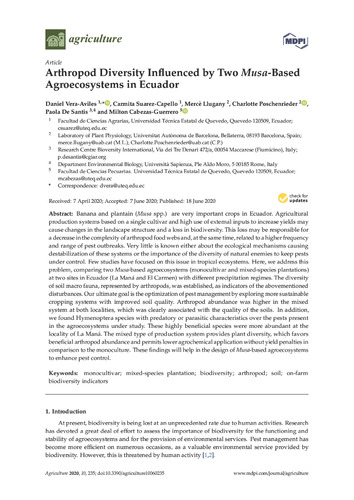Arthropod diversity influenced by two Musa-based agroecosystems in Ecuador
Banana and plantain (Musa spp.) are very important crops in Ecuador. Agricultural production systems based on a single cultivar and high use of external inputs to increase yields may cause changes in the landscape structure and a loss in biodiversity. This loss may be responsible for a decrease in the complexity of arthropod food webs and, at the same time, related to a higher frequency and range of pest outbreaks. Very little is known either about the ecological mechanisms causing destabilization of these systems or the importance of the diversity of natural enemies to keep pests under control. Few studies have focused on this issue in tropical ecosystems. Here, we address this problem, comparing two Musa-based agroecosystems (monocultivar and mixed-species plantations) at two sites in Ecuador (La Maná and El Carmen) with different precipitation regimes. The diversity of soil macro fauna, represented by arthropods, was established, as indicators of the abovementioned disturbances. Our ultimate goal is the optimization of pest management by exploring more sustainable cropping systems with improved soil quality. Arthropod abundance was higher in the mixed system at both localities, which was clearly associated with the quality of the soils. In addition, we found Hymenoptera species with predatory or parasitic characteristics over the pests present in the agroecosystems under study. These highly beneficial species were more abundant at the locality of La Maná. The mixed type of production system provides plant diversity, which favors beneficial arthropod abundance and permits lower agrochemical application without yield penalties in comparison to the monoculture. These findings will help in the design of Musa-based agroecosystems to enhance pest control.

